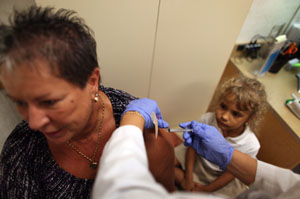In recent years, walk-in health clinics have become commonplace in groceries and drugstores as well as at retailers such as Wal-Mart and Target. The clinics regularly treat acute problems such as strep throat and ear infections, but many are also adding primary care and preventive services such as physical exams and chronic disease monitoring.
In 2009 the Rand Corp. compared care and costs for treating three common illnesses in different settings. In that study, retail clinics cost at least 30 percent less than physicians’ offices, urgent care centers and emergency departments, while the quality of care was at least as good.
With 565 drugstore clinics in 25 states and the District, MinuteClinic, a division of CVS Caremark, is the largest walk-in clinic operator by far. The company plans to reach a total of 1,000 by 2016. I talked with MinuteClinic President Andrew Sussman about what’s in store for his business. Here are excerpts of that conversation, edited for style and space.
Q. Why the big push to add clinics?
A. We continue to see a shortage of primary-care physicians, which we think will get worse. In our markets, we see a number of contributing factors, including an increasingly aging population and an epidemic of obesity that affects one-third of the population. So there’s a rising level of demand with a shortage of providers.
Q. Where is the company adding clinics in coming months?
A. We just opened in San Antonio, Texas, about a month ago, and we’ve been expanding in central Massachusetts. We’re planning on opening in Cincinnati and we’ll be opening in Hawaii. There are other states on the drawing board, too.
Q. What proportion of people who visit MinuteClinic are insured? How does that work?
A. Eighty-five percent of our patients are insured. Almost all insurers accept MinuteClinic as an in-network visit. Often patients pay a primary-care co-pay and we bill a third party for the remainder. For the uninsured, we have transparent, low pricing: The average visit is $79.
Q. MinuteClinic is staffed largely by nurse practitioners, and physicians have expressed concerns about that. To what extent do MinuteClinic nurse practitioners serve as primary-care providers?
A. About half of our patients don’t have a primary-care physician. If they don’t, we have a list of physicians in the area that are accepting new patients that we give them. We do that to make sure they get hooked up with a primary-care medical home (a provider that ensures comprehensive, coordinated care). We don’t provide all the services of a medical home. But we work very closely with physician practices.
Q. One of the concerns physicians and patient advocates raise is about continuity of care. They say a patient’s primary-care physician may not know about the ear infection or sore throat the patient was treated for at a MinuteClinic. How do you answer them?
A. We do several things to prevent the problem. At the end of every visit, we give a copy of the medical record to the patient. And we send a copy to the (patient’s) physician if the patient gives permission. And as we integrate with health systems, we can do that very promptly in the electronic medical record. We send medical records of patient visits to physicians every night, usually by fax, since lots of them don’t have electronic medical records.
Q. Tell me more about the integration with other health-care systems.
A. We’ve now completed affiliations with 18 health-care organizations, including large systems like the Cleveland Clinic. The organizations we’re affiliated with are largely led by physicians and physician groups. By creating health system affiliations and programs where some of a patient’s care can be in our lower-cost setting, it helps lower the overall cost of care. As we move forward, we represent a convenient point of access that ties in with the larger health-care system.
Q. Some critics have said that nurse practitioners at walk-in clinics may not have enough training to recognize serious medical problems and refer patients to other settings when necessary. Have any MinuteClinics been sued for misdiagnosis or mistreatment?
A. We deliver extremely high-quality care. Like any organization, we don’t discuss cases. We’re accredited by the Joint Commission, the organization that accredits hospitals and other providers. The Rand study found that on 14 objective measures of quality, MinuteClinic did as well [as] or better than other places of care.
Q. Some experts say that although the clinics provide good clinical services, they need to figure out how to make money. Are MinuteClinics profitable?
A. By the end of 2011, we reached break-even on an all-in basis, with all costs and benefits to the company accounted for. We continue to make investments in the company. We had significant revenue growth in the first quarter (of 2012): 22 percent.
Please send comments or ideas for future topics for the Insuring Your Health column to questions@kffhealthnews.org.









